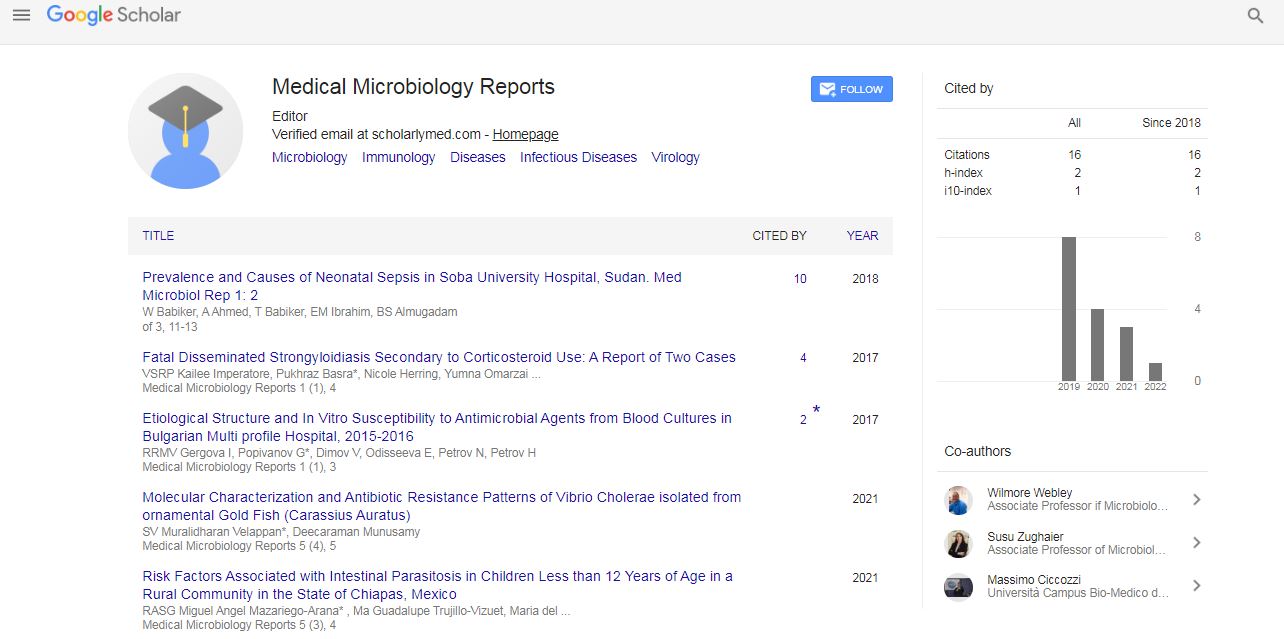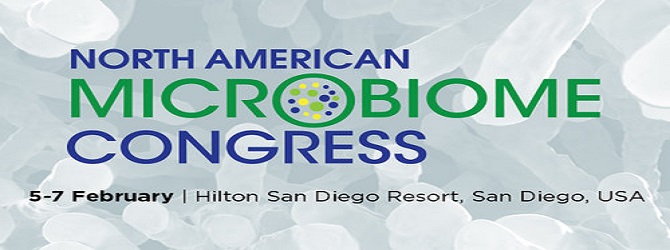Perspective, Med Microbiol Rep Vol: 6 Issue: 3
Antifungal Agents Mechanisms of Resistance with Bacterial Resistance
Rogers*
Department of Molecular Genetics, University of Toronto, Toronto, Ontario, Canada
*Corresponding Author: Rogers
Department of Molecular Genetics, University of Toronto, Toronto, Ontario, Canada
Email: microgers415@gmail.com
Received date: May 02, 2022, Manuscript No: MMR-22-13491;
Editor assigned date: May 05, 2022, PreQC No. MMR-22-13491 (PQ);
Reviewed date: May 16, 2022, QC No. MMR-22-13491;
Revised date: May 26, 2022, Manuscript No. MMR-22-13491 (R);
Published date: June 02, 2022, DOI: 10.4172/mmr.1000321
Citation: Rogers (2022) Antifungal Agents Mechanisms of Resistance with Bacterial Resistance. Med Microbiol Rep 6:3.
Keywords: Bacterial Resistance
Description
The worldwide weight of contagious contaminations is developing. In excess of 300 million individuals are accepted to experience the ill effects of a genuine contagious contamination coming about in more than 1,350,000 passings. Contagious contaminations cause perilous intense sicknesses, similar to Cryptococcus’s and intrusive aspergillosis, extreme ongoing illnesses, for example, hypersensitive bronchopulmonary aspergillosis, or they might introduce lessundermining shallow diseases, like Candida vaginitis or oral candidiasis. Most obtrusive parasitic contaminations happen as an outcome of invulnerable concealment that outcomes from conditions, like AIDS or from therapies, like chemotherapy for disease, immunosuppressive treatment for organ transplantation, and corticosteroid treatment for irritation. Over 90% of detailed parasitic related passings result from species having a place with three genera: Cryptococcus, Candida, and Aspergillus.
Inability to treat actually, on account of deficient or deferred diagnostics, may bring about genuine persistent disease or visual impairment or might be deadly. Acknowledgment of the significance of contagious diseases has prompted a sensational ascent in the utilization of antifungal specialists for the treatment and counteraction of contamination. Sadly, the treatment choices are profoundly restricted, as there are not many substance classes addressed by existing antifungal medications. The antifungal medication classes include: polyenes, azoles, allylamines, flucytosine, and echinocandins. The azoles (e.g., fluconazole, voriconazole, and posaconazole) and allylamines (e.g., terbinafine) restrain ergosterol biosynthesis, though polyenes (e.g., amphotericin B) tie to ergosterol in the plasma film, where they structure huge pores that upset cell work. Flucytosine (5- fluorocytosine) restrains pyrimidine digestion and DNA combination. At long last, the echinocandins (caspofungin, anidulafungin, and micafungin) are cell divider - dynamic specialists that hinder the biosynthesis of b-1,3-Dglucan, a significant primary part of the contagious cell divider. The inescapable utilization of antifungal specialists is dared to be a component that advances drug opposition. The development of procured drug obstruction among common contagious microorganisms limits treatment choices, which modifies patient administration. A more prominent comprehension of instrument explicit opposition and the natural factors that add to obstruction rise is basic to foster better therapeutics, and to further develop diagnostics and intercession procedures that might survive and forestall obstruction. The itemized and complex organic nature of antifungal medication opposition instruments will be investigated in this survey with an accentuation on azoles and echinocandins, the two primary classes of medications utilized as first-line treatment.
Alterations In Ergo Sterol Biosynthetic Enzymes
Every one of the antifungal classes uses an alternate means to kill or restrain the development of parasitic microorganisms. Components of antifungal opposition are either essential or optional, and are connected with natural or gained attributes of the parasitic microbe that obstruct the antifungal instrument of the particular medication/ drug class or that lower target drug levels. Opposition can likewise happen when natural variables lead to colonization or supplanting of a helpless animal category with a safe one. The antifungal impacts of both polyene and azole antifungals are because of activities on the contagious cell layer, while echinocandins act by upsetting the parasitic cell divider. 5FC goes about as an antimetabolite to impede DNA and RNA amalgamation. As talked about more meticulously beneath, an assortment of systems of obstruction have been portrayed for azoles and yeasts as well as filamentous growths. Echinocandin obstruction in yeasts is interceded by means of point changes bringing about target adjustment, and a comparable component has all the earmarks of being usable for arising echinocandin opposition in molds. Proposed instruments of polyene opposition in molds incorporate diminished admittance to the medication focus because of changed film ergosterol content, collection of different sterols and decreased intercalation, and expanded catalase action, prompting a decrease in oxidative harm. Presently, yeast protection from polyenes is exceptionally low. Optional obstruction of yeasts to 5FC is interceded by enzymatic adjustments that either impedes drug take-up into the cell or the change of 5FC to 5-fluorouracil or 5-fluorouracil to 5-fluorouridine monophosphate.
Azoles restrain parasitic development by obstructing biosynthesis of ergosterol in the contagious cell film. All the more explicitly, azole drugs tie and restrain the protein lanosterol sterol-demethylase in yeasts and sterol-demethylase in molds, which are associated with the transformation of lanosterol into ergo sterol. Accordingly, ergosterol content in the cell layer is exhausted, film construction and capacities are changed, and contagious development is hindered. As far as azole opposition, four head systems have been depicted in Candida species. More than one component might be usable in a given safe strain, and the progressions prompting obstruction can happen in arrangement and may make added substance impacts or lead to cross-opposition.
Fungal Resistance
Undeniable level azole obstruction in a few Candida animal categories associates with overexpression in the plasma layer of proteins that siphon the medication out of the cell, along these lines diminishing intracellular azole focuses to levels at which Erg11p isn't repressed. There are two primary classes of effl ux siphons: ATPrestricting tape (ABC) proteins and significant facilitator superfamily pumps. These layer proteins siphon compounds across cell films utilizing different energy sources. The ABC proteins are essential carriers that utilization the hydrolysis of ATP. The MFS siphons are auxiliary carriers that use the proton-intention force across the plasma film.
ABC siphons have significant physiological capacities and are available in all creatures; most parasitic species have numerous ABC genes. The sequencing of the S. cerevisiae genome64 uncovered that it contains ABC qualities. C. albicans has a comparative number of ABC qualities and C. glabrata has around 66% that number. A lot bigger quantities of ABC qualities are found in a fumigatus and C. neoformans. In a few pathogenic growths the statement of ABC qualities has been related with expanded protection from azole antifungals. In C. albicans, transcriptional upregulation of ABC qualities CDR1 and CDR2 has been shown, in vitro, for FLC-safe confines comparative with their vulnerable parental strains. Overexpression of ABC qualities in azole-safe confines of C. glabrata and C. neoformans has additionally been accounted for. In C. krusei, the statement of the ABC efflux siphon in blend with a heartlessness of Erg11p to azoles is believed to be liable for its intrinsic azole opposition aggregate.
 Spanish
Spanish  Chinese
Chinese  Russian
Russian  German
German  French
French  Japanese
Japanese  Portuguese
Portuguese  Hindi
Hindi 
